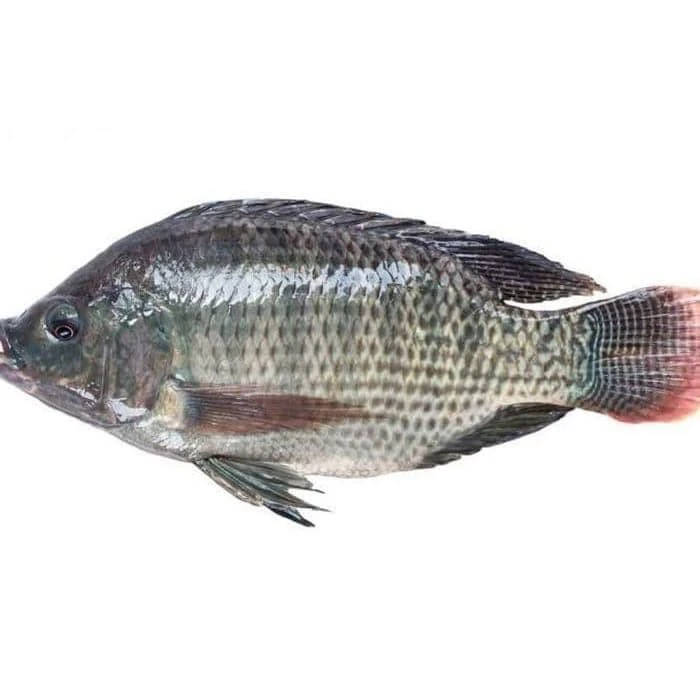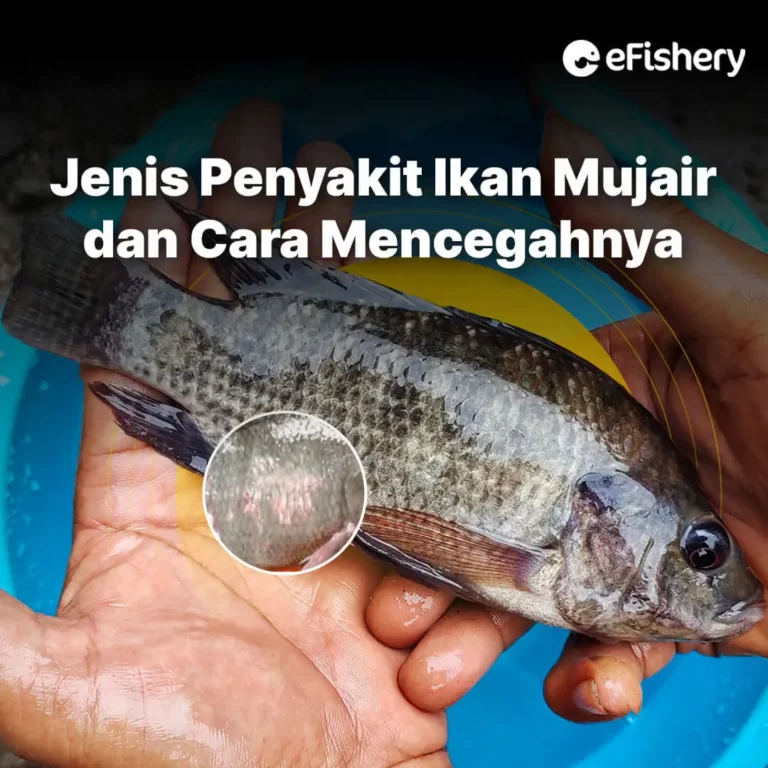Umumnya faktor yang menggagalkan budidaya ikan mujair adalah penyakit yang menyerang mujair. Karenanya sebagai Pembudidaya, Bapak/Ibu perlu mengenali gejala dan cara menangani penyakit ikan mujair agar tidak mendatangkan kerugian.
The main aspects that make tilapia fish susceptible to disease are pests and viruses, for example pests such as frogs, snakes, monitor lizards, cybister larvae, bebeasan (notonecta), lingsang, to birds. These pests and diseases must be controlled immediately so as not to affect the growth and development of tilapia fish.
This article will thoroughly examine the various diseases of tilapia fish and how to treat diseases in tilapia fish. Let's listen!
Various Kinds of Mujair Fish Diseases

There are 6 types of tilapia fish diseases that you should be aware of and know how to deal with these tilapia fish diseases so as not to cause harm.
1. Penducle disease
Penducle disease is also known as cold water disease or cold water descareases. Generally, Flexibacter psychrophila bacteria measuring 6 microns will appear when the water temperature reaches 16 degrees Celsius. Symptoms of tilapia attacked by penducle disease include fish that look weak, lose their appetite, and develop ulcers or necrosis on the skin.
The way to treat penducle disease is by soaking the symptomatic fish in a 10 ppm oxytetracycline solution for 30 minutes (100 mg/liter). Another alternative treatment that you can do is mix sulfisoxazole in tilapia fish feed at a dose of 100 mg for 1 kg of tilapia weight.
Before mixing sulfisoxazole, first dilute it or dilute it in 15 cc of water. After the sulfisoxazole liquid and feed are mixed, leave it in the open space to dry, then give it to the sick tilapia for 10-20 days in a row.
2. Itching
Not only humans, fish can also get hives. The symptoms are seen when the fish often rub their bodies against the pond wall or on hard objects accompanied by symptoms of the fish looking weaker. Generally, fish that are attacked by hives are attacked by Trichodina sp. on the skin, fins, and gills.
To prevent tilapia from developing itching, you can reduce the amount of stocking density in the aquaculture pond and ensure the cleanliness of the pond. Whereas in fish that have been exposed to the disease, the treatment method is to soak the fish in a formalin solution of 150-200 ml/m3 or the equivalent of 150-200 ppm for 15 minutes. Another treatment alternative is to soak the fish in a solution of 19 grams/cubic meter of malachite green oxalate (MGO) for 24 hours.
3. Lernaean Disease
Lernaea disease is a disease that attacks tilapia fish due to tiny shrimp that still belong to the Lernea sp.
If not treated immediately, the attached parasites will prick the body. This is because when viewed from the naked eye without any aids, the parasite's body shape is like a fishing hook.
To treat it, you can soak the sick tilapia in 250 cc of formalin which has been diluted and mixed with 1 cubic meter of clean water. Soak the sick fish for 10 minutes. Do this method repeatedly for 3 days with a repetition duration of 3 times a day.
The purpose of this tilapia immersion is to relieve pain in the fish's body and to carefully cut off the parasites. You must be extra careful and more careful when treating tilapia fish with Lernaea disease to minimize the appearance of new wounds on the fish's body.
4. Fish Louse Disease (Argulus)
The cause of fish lice disease in tilapia is the parasite Argulus sp. which is still classified as small shrimp. Argulus sp. is a blood-sucking parasite that attaches to the gills, skin, and fins of fish.
The characteristics of fish affected by this parasite include loss of appetite so that the body looks thinner and red spots appear on the body. If you ignore these characteristics, then there is a great potential for tilapia to die due to lack of blood.
The way to deal with fish lice in tilapia fish is to soak the sick fish in a salt solution of 20 grams/liter for 5 minutes. You can also use an ammonia salt solution as an alternative at a rate of 12.3 grams/liter for 5-10 minutes.
In addition, clean the pond where sick fish live by liming. Initially dry the cultivation pond then sprinkle lime as much as 200 grams / square meter.
5. Edwardsiella disease
As the name implies, Edwardsiella disease is a disease of tilapia fish caused by a bacterium called Edwardsiella measuring 0.5-0.75 microns.
Symptoms of tilapia infected with this bacteria include the appearance of small wounds on the skin and flesh, followed by bleeding. Small wounds that fish have over time will grow into ulcers and ooze pus. If not treated immediately, the wound will spread to the liver and kidneys.
How to treat it by mixing sulfamerazine in tilapia feed. Mix 100-200 mg of sulfamerazine in feed for fish weighing 1 kg. Dilute sulfamerazine first in 1 cubic meter of clean water, then spray it on the fish feed. After the feed has been allowed to stand and aerated until dry, give the sick fish a mixture of sulfamerazine for 3 days in a row.
6. White Spot Disease
White spot disease is a tilapia fish disease that attacks the mucous cells, scales, and gill layers of fish which originate from the protozoa bacteria Incthyrius multifilis. The cause could be due to the pool temperature being too low, poor water and feed quality, or transmission from fellow tilapia. Because if in one pond it is identified that tilapia are affected by white spot disease, then the fish around it will be infected with the disease.
Symptoms of white spot disease for tilapia include slow movement of tilapia, often rubbing its body against the pool wall, difficulty breathing, white spots on the gills and fins, damaged mucus layer, and bleeding on the fins and gills.
The way to deal with this disease in tilapia fish is to soak the fish in a solution of table salt as much as 1-3 g/100 cc of water for 5-10 minutes. Soak sick fish for 3-5 days with an interval of one day.
In addition to the diseases that have been mentioned, there are other causes that can interfere with tilapia fish growth, namely pests. To control tilapia fish pests, the following is a table of symptoms, causes, and ways to control pests.
| Tilapia Fish Pests | Symptoms and Impact | Reason | Control |
| Frog | Frogs spread disease through feces and eat tilapia seeds Frogs eat tilapia seeds. In addition, frog droppings can cause disease for tilapia | Dirty pool environment | Picking up eggs floating in the water, doing sanitation, and catching frogs |
| Snakes, monitor lizards and forms | Mujair gradually decreased in number | The pool and bush environment around is dirty | Thoroughly sanitizing ponds, making fences, traps and beds |
| Ucrit or cybister larvae | Mujair looks thin, fish growth is slow, until the fish suddenly dies | Dirty pool environment and food residue deposits | Discard eggs that float on the surface of the water and build fences or pest traps |
| Free "notonecta" | The fish looks thin, the tilapia's appetite decreases, until the fish dies | Water circulation is not working and the pool environment is dirty | Routinely clean and replace pool water, catch pests directly, and dissolve kerosene on the surface of the water |
| Bird | Fry and adult fish are slowly decreasing | There are no nets, bamboo or additional security over the pool | Install fine netting over ponds, bird traps or, bamboo barriers and the like |
| Lingsang | Mujair seeds die quickly | There are no nets or extra security over the pool and the surroundings of the pool are filthy | Routinely clean around the pool and make traps |
How to Prevent Mujair Fish Disease
It is better to take precautions before tilapia are exposed to viruses, bacteria, fungi, pests and other diseases. The following are preventive steps that you can take:
- Schedule regular water changes.
- Clean the pond properly, especially on the surface of the pond so that no residual feed settles.
- Creating an ideal and parallel sluice system.
- Make sanita or filter around the pond.
- Find out how to maintain the right mujair so that it is free from disease.
- Avoid tilapia stocking in limits exceeding capacity.
- Dry the pond regularly and regularly after harvest.
- Transfer seeds or harvest carefully and correctly.
- Provide feed with nutritional levels and the right amount.
- Create an additional security system so that pests from outside such as birds, frogs, snakes, and so on cannot enter the pond.
- Quarantine fish that are attacked by pests and diseases according to the type of disease.
Butuh Bantuan Budidaya Ikan Mujair?

Beberapa penyakit ikan mujair di atas bisa mengancam kesehatan ikan jika Bapak/Ibu tidak segera melakukan pencegahan sedini mungkin. Tapi kini, Bapak/Ibu tidak perlu khawatir karena sekarang sudah ada aplikasi serba ada eFisheryKu. eFisheryKu is the application of eFishery which is the mainstay of cultivators in Indonesia from the beginning of the cultivation cycle to harvest.
eFisheryKu menyediakan pakan ikan berkualitas dengan harga terbaik di fitur Buy Feed, bantuan akses ke lembaga keuangan terpercaya untuk mendukung bisnis budidaya Bapak/Ibu dengan Kabayan, dan tempat menjual ikan hasil panen Bapak/Ibu dengan harga terbaik di fitur Fish Stall. Besides that, eFisheryKu juga sering melakukan diskusi dengan ahli budidaya melalui webinar gratis.
Menarik sekali bukan? Yuk, downloads eFisheryKu sekarang dengan klik tombol di bawah ini!
Questions Regarding Mujair Fish Disease
There are 6 types of tilapia fish diseases, including penducle disease, itching disease, lernea, fish lice, white spot disease, and Edwardsiella disease.
The way to prevent tilapia from being attacked by diseases and pests is to routinely clean the pond and its surroundings, provide feed according to the tilapia needs, make traps or special security systems, and find out how to properly care for tilapia fish.
There are two ways to deal with tilapia fish disease caused by parasites. If the lernea parasite attacks tilapia, then the way to treat it is by soaking tilapia in 250 cc of formalin for 10 minutes. Whereas if the parasite Argulus sp. sticks, soak tilapia in a salt solution of 20 g/liter for 5 minutes.
- https://www.djpb.kkp.go.id/index.php/mobile/arsip/c/541/PASTIKAN-PASOKAN-BENIH-KKP-KEMBANGKAN-TEKNOLOGI-CORONG/?category_id=14
- https://id.scribd.com/document/540549795/Penetasan-Telur-Ikan-Nila-Menggunakan-Corong-Penetasan
- https://www.dictio.id/t/apa-yang-menyebabkan-telur-ikan-gagal-menetas/106383
- https://kkp.go.id/djpb/infografis-detail/12150-penetasan-telur-ikan-nila-sistem-corong
